By Brian Heiler
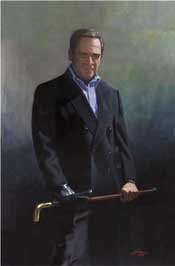 Most
Mego collectors own artwork by Harold Shull and don't even know
it, this accomplished illustrator and painter just happened to
be the art director for a little company known as Mego.
Most
Mego collectors own artwork by Harold Shull and don't even know
it, this accomplished illustrator and painter just happened to
be the art director for a little company known as Mego.
Mr Shull was kind enough to sit down with the Museum and share his thoughts on what was obviously a very happy time.
MM: So how did you get into commercial art?
It was around 1969 or 70, I was living with a couple of guys, I'm going to be a name dropper here, Michael Kaluta, Jeff Jones and Bernie Wrightson. Bernie, Michael and myself lived in the same apartment on the eighth floor and Jeff Jones lived on the first floor.
MM: This was in 70?
Yes, this was before they formed the studio. Bernie and I knew each other back in Baltimore, we became fast friends. We made a pact, whoever gets to New York City first, would invite the other one to stay until he gets his own place and all that.
So it was always a given that I would be the first one to get there, as it turns out because of me getting married, Bernie got to New York first. So when I planned on going to the city I called and Bernie said "There's no bed but there's a cot you can use, come on man". So I moved in, I lived with them for about a year.
(Bernie, Mike and Jeff) stayed in art, meaning comic books and painting and I went into the commercial aspect of it because my wife became pregnant, I chose to go the practical way. Meaning - a check every week.
MM: The comic industry loses many people to commercial art.
Oh yeah, I mean I've got a house in the suburbs raising three kids through
college, you've got to have a regular check coming through. I chose to [go
commercial] and also to keep my fingers in art on the side, I did book and movie
illustrations.
As a full time employment, I made my income in advertising and commercial art while I supplemented my income as an illustrator. I chose that route while they chose probably in the long run, the best route. The short run I had the family, I had mouths to feed, now I'm going back to pick up where I left off. That's basically why my career went that way.
Looking back, I wouldn't change a thing. I made my decisions because I wanted to not because I was forced into it.
It all started right there at Mego Toys, that was my first exposure to art and design in New York City.
MM: So how did things get started with Mego?
I was doing book illustrations and I did a couple of famous monsters illustrations for James Warren. I was trying to make it in the comic book field but I was much more a comic book cover artist than an interior artist.
In those days, they didn't have four color comic book covers like they do today. So basically it was just comic book artists doing the covers so there were very few jobs for guys like me out there.
So a friend of mine, I don't know if it was Neal Adams or Bernie Wrightson said, "You know Harold, you ought to check out some of the toy companies because they have a lot of work" and that's what I did, I knocked on a lot of doors and wandered into Mego.
Marty Harrison, at the time was art director and he kept me in the full time freelance category on the premises where I was doing comp and illustration work.
MM: So what kind of packaging were you doing at the time?
All kinds, when it comes to Mego I designed most if not all of Star Trek, the action figures and the original packaging. I did all the packaging for Micronauts but that was after I became art director.
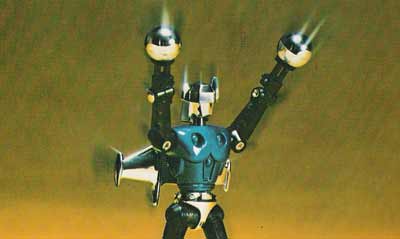
MM: So that was around 1976?
No it was earlier than that, around 1970 to 1971. I designed the micronauts and CB Mchaul. I did part of the illustration, the truck box. There were things like Sonny and Cher and Muhammad Ali that were strictly photography at that time.
I ran into a problem, when i was art director at Mego, I was freelancing on the side. I was called into a room with a bunch of suits and they said "Harold we've got a problem in that Vanity Fair has ripped off one of our packages and we want to take them to court and since you designed the package, we wanted you in on the meeting"
So one of the lawyers said "Let's set this straight it may not go that far because whoever designed this package was clever, it's not a rip off but it's so similar"
I was standing there saying "gulp" because I had designed both of them.
MM: Do you remember what it was?
It was a desktop toy, a set of walkie talkies with a command module and it was basically the same toy. You know how they make things in the orient, make the same toy and put the same label on it.
Whenever I designed a toy, for example i designed the Planetarium for Mego, that was my idea with my buddy Harvey Schlackman. So when we sent it over the orient and it was done for Mego but we knew that in the orient they were going to produce another one.

Whenever you designed a toy and it was sent to the orient, there was two made, not one. One for them over there and one for your license over here because most cases we'd go for an international license but not a global.
We got ripped on that all the time, I did a disco light record player once and i happened to notice it in the toy mags [under different names] those guys are really something.
It was a given fact, that's what happened in those days. Nowadays, there's hardly anything happening today, there is hardly any toy field left.
MM: It is starting to shrink.
That's how I got out of the toy field , in the late seventies I had opened my own company and had three offices in New York City. Since, I was weaned on the toy field that's where my accounts lied.
I had four, maybe five guys go belly up on me in a period of four months. It totally wiped me out, I lost everything except my home and I left the city and I went into a different field because i lost my income and I lost my source of income, which was the toy field
MM: I've heard similar stories from others.
When it hit me, Knickerbocker went under, Mego went under, Ideal had gone under before that, HG went under and I had work being done for all these companies. The only company that paid me what they owed me was HG, the rest of them left me holding the bag. That¹s how I bought my house. I took the money that HG paid me and kept putting it in the bank. This became my down payment on my house.
I went into believe it or not the pharmaceutical field designing direct mail and anatomical wall charts for offices and things like that.
I'll tell you the two things, and this is my opinion, that destroyed the toy field, It started with the oil crunch in the seventies, when they had the so called oil crisis which was all fabricated, it wasn't real.
And then came Atari, which was the beginning of the video games. Video games just put the icing on the cake and put all these toy companies under because what kid wants to play with a toy truck or doll when he's got a video game where he can conquer the world?
I'm not crying over spilled milk here, that's the way it was. But back to Mego which is what we're here to talk about.
MM: Sure!
Mego to me, was the number 2 or 3 toy company in the whole world and they could have wiped anybody out but somebody passed up on Star Wars.
The reason I heard at the time, was that 20th Century Fox only wanted a blanket coverage meaning if you take it, you're taking everything.
MM: So board games, die cast ?
Yeah, whoever it was didn't want to invest that kind of money on it. Well, that was history. [laughs]
Monday when we came to work when he found out he bought out Buck Rogers, Black Hole and no Star Wars we all said "Oh my God" because at that time that's all people were talking about
We had photos issued to us of what the characters were going to look like, so we were already projecting what we could do with a license like that.
MM: So you were producing Star Wars mockups?
Oh no, I mean projecting in the creative department what we could do. We'd have action figures over here, we'd have this and then to find out it was offered to Mego 100% and it was turned down it was just "Oh My God".
So instead we got Black Hole and Buck Rogers, we thought "yeah it's OK but it's no Star Wars"
MM: I guess the Sales showed that.
Yep, also the history of the company shows that.
That was one of the big "boo boos" I think Mego could have been around if they have picked up that license.
I should mention and this is from my heart, that it was my favorite job of all time.
MM: Really?
Hell yeah, I loved it, are you kidding me?
Where else could you go to work and put on your hat and work on GI Joe, take off that hat work on Superman, take that off and work on Star Trek?
It was like I was living my childhood dreams and also getting paid for it.
I loved every minute of it, the only reason I left Mego was my buddy Harvey and myself wanted to open our own company, it was later called the Graphics Center.
That's where we got into working for different toy companies, we were still working for Mego because Neal (Kublan) went to Marty Abrams "Harold is leaving because he wants to start his own company" So we kept Mego as an account.
The art director that came in after me decided that "Harold's been here longer than me so let's shoot some work over to him" So I left with a good relationship with (Mego).
If you were to ask, what the basis of Mego's success was, it would have to be the licenses. They did a good job of producing beautiful dolls and things like that but the licenses that Mego came up with all the time just kept them on top.
MM: It's even like that in collector circles, the licensed items are still the most desirable.
Well, the Micronauts that did fantastic for a while.
MM: Micronauts still have their own fan base to this day.
I'll be darned. When I took over the helm at the art department, Marty Harrison still had final say but he always let me have a freedom of doing what I wanted to do.
There were two rules of thumbs in the toy field that people tried to adhere to because "they" said so and I hate that word "they."
One of which was don't use yellow on a toy package because it makes a package look cheap and number two is don't use black because it makes the package look cosmetic.
So the first rule I wanted to break when I did Micronauts, was to have a solid black package. I always felt black helped colors to pop in your eye and that's the reason and I said I was going to stick by it.
Also when I designed the Micronaut packages, I wanted to do something that was totally different. Since it was all robots and mechanical creatures, I wanted to do something that had a little bit of life to it instead of just a still life shot.
So I came in with the zoom photography. I went over to the David Shore Studio who was the photographer (for Mego) and I plotted out the zoom for him. Where it was so many seconds on one shot, so many seconds on another and he would freeze frame when he got to the item.
Biotron was actually the first shot that I did, I brought it over to Marty Harrison and I said "This is the way I want to go with the Micronauts" (Marty) went "Fantastic Harold!" he said "Now go back to Dave Shore and have him make a five foot poster of that and in tomorrow's meeting we'll put it right in Marty Abrams eyes"
We went up to the meeting and (Marty) said "What do you guys have planned for the Micronauts" and I had it laying behind his couch , so I stood it up and after (Marty Abrams) saw it, he said "When are you gonna get started?"
We said "already, we've already got the mechanicals started on the boxes"
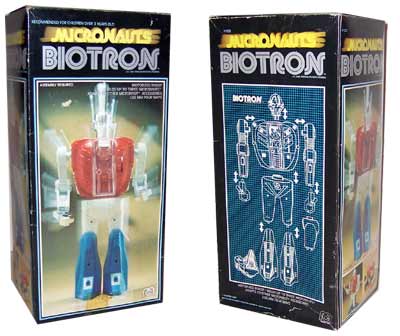
MM: On the Micronauts, you went for photographs right away?
Right off the bat, the characters themselves were so beautiful, I thought. When I did the research I saw how beautiful these things were designed. I thought "why hide that?"
We went into illustration later on, I don't think I did.
MM: Ken Kelly did some
Yeah, Ken Kelly did some because Marty Harrison wanted to do something different for a change. We got Ken Kelly, a friend of mine to do the illustration for them.
But before that it was "Let's just show them how they are" but to get some movement or excitement in there, I decided to go into that zoom photography.
I had two ways of doing it, Dave Shore and I worked it out two ways. I had it zooming into you, in other words coming forward. I looked at it and said "Let's try something else let's zoom back "
[Shore was worried about the image] "I said it doesn't matter, I want to bring people into the package" and so by doing that, reversing the zoom and that kind of drags you into the characters eyes,
MM: It was obviously a huge hit
Oh yeah, it won the packaging of the year award in that category.
MM: So you did the Star Trek Packaging as well.
Yeah I did most of the Star Trek packaging, in those days, I think i did most of the illustrations on.
Marty Harrison saw my illustration work and he wanted me to work on just about every package that was done and so he had a way of taking things out my hands before they were finished.
They were printed before they were actually finished! I had Spock sitting there with a little boy [The Phaser Battle Game] and his face wasn't even finished, I didn't even touch it and [Marty Harris] said "It's finished, it's good enough!"
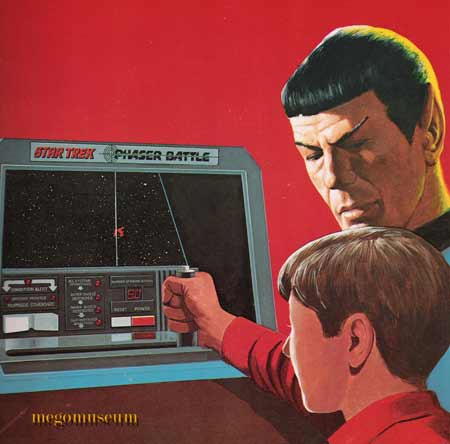
I'd go "wait! wait!" and he did that to me all the time, he'd take things out of my hands before they were finished just to keep going. I look back at some of those painting I've done and they weren't even complete.
Whenever I look at some of those old illustrations I think "son of a , I was going to do this and that"
The characters for the action figure dolls, I did at home. I did those when i was a freelancer.
MM: What sort of source material did you have for those?
I took, we always had stills supplied to us from Paramount and in those days you didn't have computers. I had a buddy named Alan Asherman [Author of the Star Trek Compendium].
[Alan] used to come over when I was living with Bernie and Mike and go through our trash cans. When you're an artist, three quarters of your work ends up in the trash can because you're working out your ideas.
He said one day "I want to make a deal with you, don't throw it away put it in a stack and I'll give you stills from my collection" So i started a file, a morgue we used to call them, that Alan Asherman supplied me.
MM: Now with the Aliens, they were somewhat fabricated.
Yes they were, they were so hot that we decided to extend the line by making up new ones (Laughter)
When I was there, (Mego) probably had the biggest art department in a toy company on the east coast, we had about twenty five people there. We had about fifteen full timers, in those days you'd call them mechanical artists, today they're called production artists.
We did it the old fashioned way, you'd make a paste up on a board and then you get type from a type house and everything is pasted together.
I also had about seven or eight freelancers, sometimes ten working off the premises. So I had the design department and the mechanical department. It was a pretty good sized department when I was art director.
It was fun, it was exciting in that you never knew what you were going to be working on when you got there in the morning, and me being the art director, I was working on most of them.
I left the kiddie dolls and the girls lines to the women. I usually didn't get involved in that because I had my choice of whatever I wanted to do. When it came to Sonny and Cher, we had Bob Mackie designing outfits for example, and that all was channeled through the girls who were working on that line because they had a feel for it.
I concentrated on the boys lines, adventure, Superheroes, and things like that - and I did have an eye for that.
MM: Now the Super heroes, how involved were you with that packaging or was that outsource?
All the artwork was outsourced in that the drawings were either done by Dick Giordano and Neal Adams. I used to go up to Continuity and sit there all the time waiting. I'd go there sometimes on my lunch break and just sit there and talk to the guys. This is when he had Rich Buckler, Russ Heath, and a string of artists working there.
MM: So the Superhero artwork was brought in?
I decided to go with the pros who knew their stuff well and did it better than anybody else.
MM: Some of the early Mego Superhero art looks like it was swiped from the comics
Yeah, that happened before i came in. Neal Adams and Dick would do these beautiful designs for me, the drawings were dynamite.
MM: The Cards for the Super heroes seem to change slightly every run, heroes scowling, smiling. What was the motivation behind that?
That came again, I think that came after me. [ Editors note: this lends weight to the theory that Mego didn't start putting the heroes on cards until the late seventies]
I was working on a lot of the Batmobile, the Super heroes play sets, Oh boy were they a fiasco because I had so many different people working on them, different styles, different this, different that.
MM: Were these were the Comic Action Heroes?
Yeah, it had all kinds of problems getting that stuff done. As big a department as we had, we had problems with the scope of the amount of work we were turning out. They had art departments in different companies that were devoted to just one license, we had guys working on Superman, Batman, Wonder Woman, Dukes of Hazzard, Buck Rogers, Sonny and Cher and then they'd have Star Trek or Wizard Of Oz waiting on their desks, they would be jumping from one license to another.
With the Micronaut packaging, I had this guy, he was from Israel, he had an eye for detail like no other artist in my department. I said to him "I want you to do the Micronauts packages and stay on that." Then I told him "You work with me, nobody else and nobody tells you what to do, do all the mechanicals on that" So I had one guy working on the Micronauts boxes, so when the original packaging was done, I had the same family affair, the same flavor.
MM: Continuity?
Yeah, all of those original boxes and packaging had the same family effect. Later on, when I was starting to have outside interests and I knew I was going into my own company that I knew it was starting to change.
MM: What with the painted boxes and such?
Yeah and different things happened, it didn't have the same effect.
In those days, when my wife and I had little kids and I would to go to "Toys R Us" to buy toys, I told her it was the same feeling as a painter gets going to a museum and seeing his artwork hanging on the wall. I hit an aisle in Toys R Us once where the whole row had my packaging on both sides. It was the same rush a painter must get seeing his work hanging in a reputable gallery.
I was doing work for Vanity Fair, Mego, Knickerbocker and others. It was like standing in a museum with my artwork hanging on the wall. That's where I come from when I say, I have nothing but great memories from the toy field.
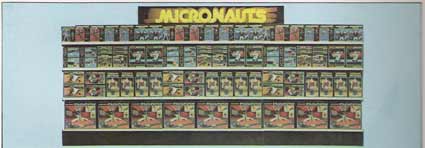
MM: How do you feel about folks having that in their basements now, whole displays of you artwork?
Oh! I didn't even know that was true! I didn't know that. That¹s fantastic.
You know I've got one bad memory about every Christmas when the kids would rip open the packages. I would have to step back or else ruin their Christmas, so I had to be quiet. That was my bad experience. Kids ripping up my art and stomping on it just to see what was inside the packages.
MM: At Mego, it was your job to hire the freelancers.
Yeah, I was art director. I designed the packages. I was doing all my design work in pencil, no computers, I would lay out all my packages and the way it was done you'd put a diagonal down through the package and you would color on an overlay with markers.
I actually got a package printed out that way (Laughs), they (The Orient) thought that's what I meant! I actually got a package printed out that way (Laughs) Sometimes you would get back things like spelling errors or grammatical mistakes being made because it was done in the orient. We'd have to send it back to be redone.
Back in those days, we had a lot of funny stories. But nowadays with the computer, you don¹t have those problems. There¹s no lack of communication.
It's much more progressive, much more advanced, and probably a lot more accurate, it has to be. Back in those days there were all kinds of stories about the Orient "Get the ship out of the orient, they're going to close down for the year of the whatever!"
There were times at their New Year, they would just shut down Hong Kong harbor for close to a month, so you'd work like crazy trying to get your shipment out of there before they closed everything down.
"And who's sticking around tonight until eight o'clock?" That's when they'd be going to work over there. So when you stuck around and talked to your contact, over there it'd be like eight in the morning while over here it would be around 7pm or 8pm. We had long days back in the 70s.
.
MM: So all printing was handled in the Orient?
Most of it, we had a couple of domestic jobs done here. If you had an exclusive, for example, if Sears had come in at one of the shows and said " I want that product as an exclusive" to be delivered on such a day. It might be a domestic print run because of the deadline. If it wasn¹t delivered on time, the contract wasn¹t worth the paper it was written on. But, the majority of it was done in the orient.
MM: Was there anything you worked on at Mego that never saw the light of day?
Oh yeah, a lot of things. Well in my case, you'd have to say design work. Sometimes you'd submit a design or two for the same package and they'd say "No that one doesn't cut it Harold, but the other does.² So sometimes 50% or more of your work wound up in the trash. I used to save those rejects but most of them got lost along the way.
It's been so many years now that I've cleaned out my flat files. I used to have the original Earl Norem Dukes of Hazzard artwork here as well.
MM: So many fans would be disappointed to hear that
I look back at my career and I think I was a little part of American History because illustration in the arts, is now being recognized as being a viable part of American art that should be hanging in museums. I went to the Brandy Wine river museum and I saw illustrators like N.C. Wyeth and Howard Pyle and all I could say is "oh My God!"
I think that's also true in the toy field, I think that's part of American history because of people like yourself, Brian, it's going to be preserved for future generations and hopefully they're going to look back at it with wonder.
MM: You certainly don't get that kind of quality on packages any more.
To have been a part of it, I feel I am very privileged and it's only by circumstance, I was lucky to be in the right place at the right time and I opened up the right door and it wasn't because they sought me out, I sought them out.I feel like I'm a very lucky guy in that respect and anybody, young people especially, I like to share my experiences with. I go to painting shows, I always relate my experiences to the young people and try to help them in any way I can.
.MM: It's really great to hear that.
My memories (of Mego) are nothing but good memories, I had a great time. A lot of hard work, tons of hard work, we worked day and night, many night hours. That's good for the spirit and it's all on the positive.Working in that field, you've got to have a bright personality to be able to create things for children. I had, of course, a much better time working with the boys lines. I loved working on the adventure and science fiction toys. I wish to heck that I could work in that field today but the field doesn't exist like it did then.
MM: Much of it is style guides
Maybe it's not a bad thing that everything is becoming electronic. It's kind of like that Twilight Zone episode where the man is on the train and the conductor keeps shouting, "Willoughby! All off for Willoughby!" and the man looks out the window but doesn't step off. When he finally steps off he goes back to a more pleasant and nicer time, that's what I think about when I think of the toy field, Willoughby.
MM: When I think of those times I feel the same way, but probably more because I was Seven
(Laughs) I may have been in my twenties but my mind set was seven or eight years
old. We had vacant rooms for toy testing and we had to wear badges, I stopped
wearing mine because everyone knew me; everything was so top secret. It was
equal to the pentagon if not more so. I'd walk by and you'd have children come
in and they'd put toys in a room and I'd look in the window. When the person
monitoring them would come out I'd ask "which one did they like the best? And did they look at the package?"
I was always curious! Once, the toy they gravitated to first was the 2 XL robot.
MM: That was big for Mego
John McNet (Mego VP of R&D) was in charge of that one. John McNet was a person who came into the toy field just when he was needed. He added a different kind of flavor to the company that I think was lacking at the time. I admired (John) for what he was capable of and his (2-xXL) was a top seller for a long time.
To show you how wrong I could be, when we came out with a new toy I would say in the back of mind "that one is going to be hot or maybe not." I didn't think 2-XL would ever sell because it cost nearly $100. I told John "Nobody is going to pay $100 for a toy" and he said something like "Harold, you're living in the caveman days, toys are becoming more and more expensive." Boy was John ever prophetic.
To view Harold's art and to speak to him about a commission or a print please visit his web site at Harold Shull.com